Hands-On With Nintendo Switch’s Mixed Bag Labo VR Kit
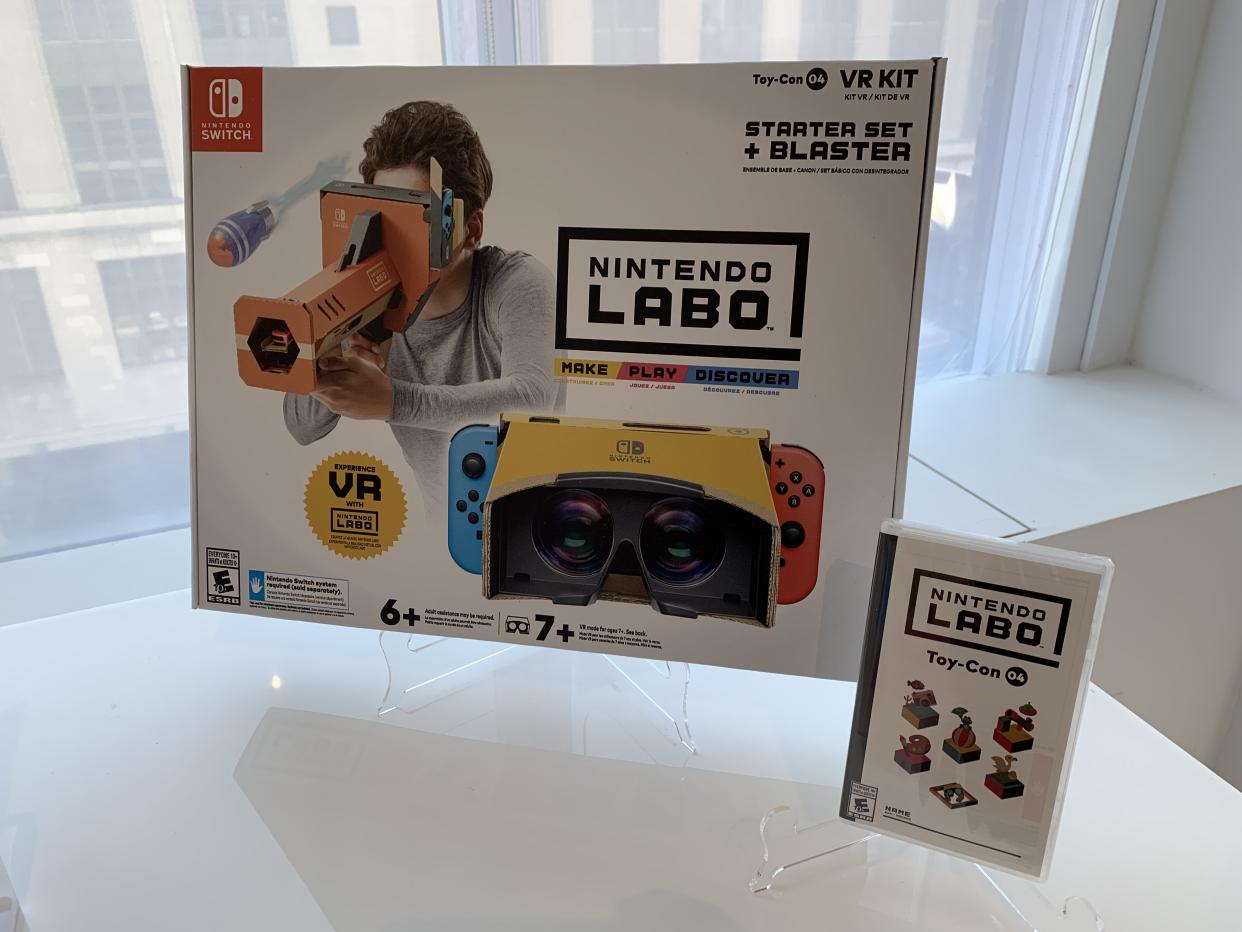
Nintendo is making a virtual reality headset … Well, Nintendo is making you make a VR headset out of cardboard. Announced earlier this month, the Nintendo Labo VR Kit is the fourth set in the company’s line of creativity minded Labo products, where players build their own “Toy-Con” controllers, then use them to play games and design their own. In the VR Kit, players build a Google Cardboard-like VR viewer, which they can pair with five different controllers — the Blaster, Camera, Bird, Elephant, and Wind Pedal. Players are also able to create their own VR experiences using the series’ signature creation tools, the Toy-Con Garage.
Nintendo outlined how the Nintendo Labo VR Kit will work for media outlets, including Variety, at an event in New York earlier this week. At the event, reporters were able to try each of Nintendo’s signature games for each of the Toy-Cons, as well as additional experiences that come with the software. All of which painted the picture of an imperfect, but interesting take on what Nintendo of America Assistant Manager Samantha Robertson described as “social, friendly VR.”
Related stories
'Vlambeer Arcade' Brings Bite-Sized Games to Nintendo Switch
'Mutant Year Zero: Road to Eden' Coming to Nintendo Switch
Rhythm Game Combines 'Crypt of the NecroDancer' Gameplay and 'Zelda'
The core component of the Labo VR kit, regardless of what Toy-Con you use, is the viewer. The viewer, which looks like a more sophisticated version of Google’s Cardboard, creates the lenses through which you view all the Labo VR games. In the same way that every Toy-Con creates holsters for the Switch console and Joy-Cons, so too do the VR Camera, Bird, Blaster, and Elephant create a way for the Viewer to lock into place. (You hold the Viewer while using the Wind Pedal, but do not attach the two). The viewer is surprisingly comfortable, considering its made of cardboard; the lenses help you focus on the screen and create the distance necessary to dispel any awkward feelings you might have about pressing your Switch against your face.
You can purchase the kit as a complete set for $79.99, or purchase the “Starter Kit” with the game, Viewer and Blaster for $39.99, then get two expansion kits for $19.99 apiece. However, it’s worth noting that you need both the Nintendo Labo VR Kit software and the Viewer to use any of the VR Toy-Cons, so players and parents looking to buy the game piecemeal will have to buy the starter kit before buying either of the expansions.
The other core VR Toy-Con, considering it comes with the starter kit, is the blaster. A pump-action rifle, players can use the Blaster in either a single-player shooting gallery called “Blaster,” where you shoot pink alien blobs. Or Kablasta, a two-player game where you shoot fruit at hungry hippos to earn their loyalty and approval. Though it is impossible to deny that it’s a gun, which may unnerve some parents, Nintendo attempts to avoid the act of simulating the action of firing a gun on the Blaster by trading in a traditional trigger for a fire button at the top of the handle.
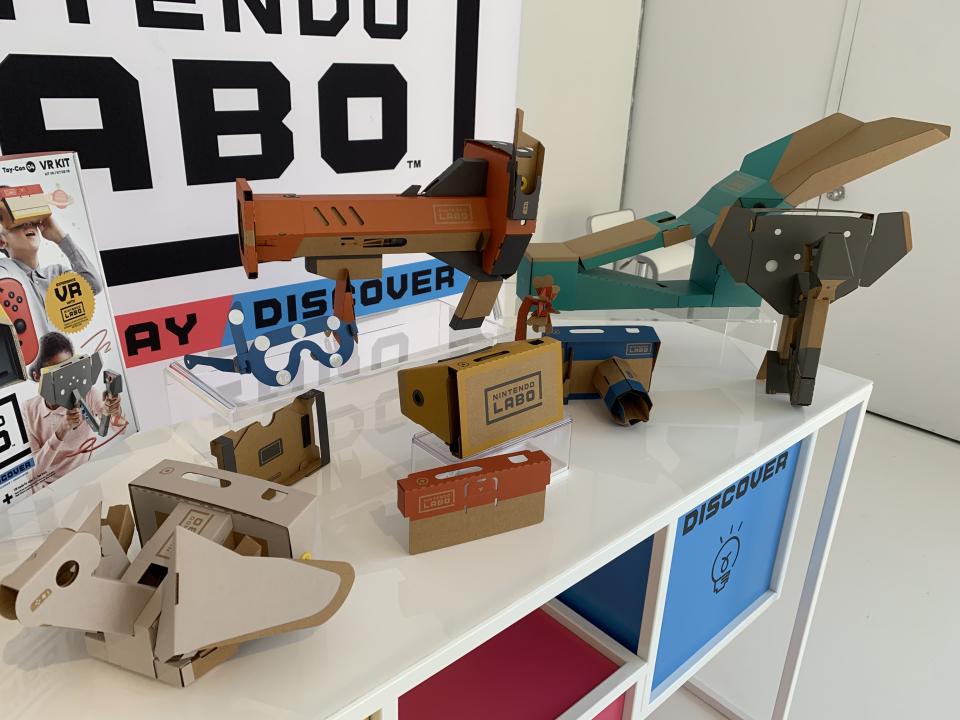
The first expansion kit comes with the two more creative Toy-Cons, a Camera and an “Elephant.” The Camera pairs with a magic-eye style search puzzle where you’re supposed to take pictures of the novel components in a 360-degree viewing area. There are two scenarios: “Ocean Camera” sends you deep under the ocean, and “House Camera” lets you shoot photos inside the zany world of the House Toy-Con from the Nintendo Labo Starter Kit.
The Elephant pairs with a VR painting tool called “Doodle.” Like Google’s VR art program, “Tilt Brush,” “Doodle” lets you paint and produce a 3D art piece in virtual space. The Labo Viewer fits into the back of the Elephant’s face, creating eyes for the mask, and a Joy-Con fits into its trunk, which serves as your brush. The Switch can be docked to and put into gallery mode to show off your work locally (in 2D). There’s a long, winding history of creative drawing programs specifically for kids, and Labo’s “Doodle” seems like a great way to introduce kids to VR. (It works pretty well on adults, too). The Elephant also works with a second game, the physic puzzler “Marble Run,” which asks players to make contraptions that will guide marbles down a specific path through a series of rings.
The second expansion serves up two more, more abstract, play focused Toy-Cons. The “Bird” Toy-Con serves as the controller for a game of the same name. After connecting the Viewer to the bird’s back, players tap levers to flap the bird’s wings, both physically and virtually, flying around an open world to finding eggs and raising them into birds that join your flock. There’s also a single-player bird-flying time trial game called “Bird Dash.”
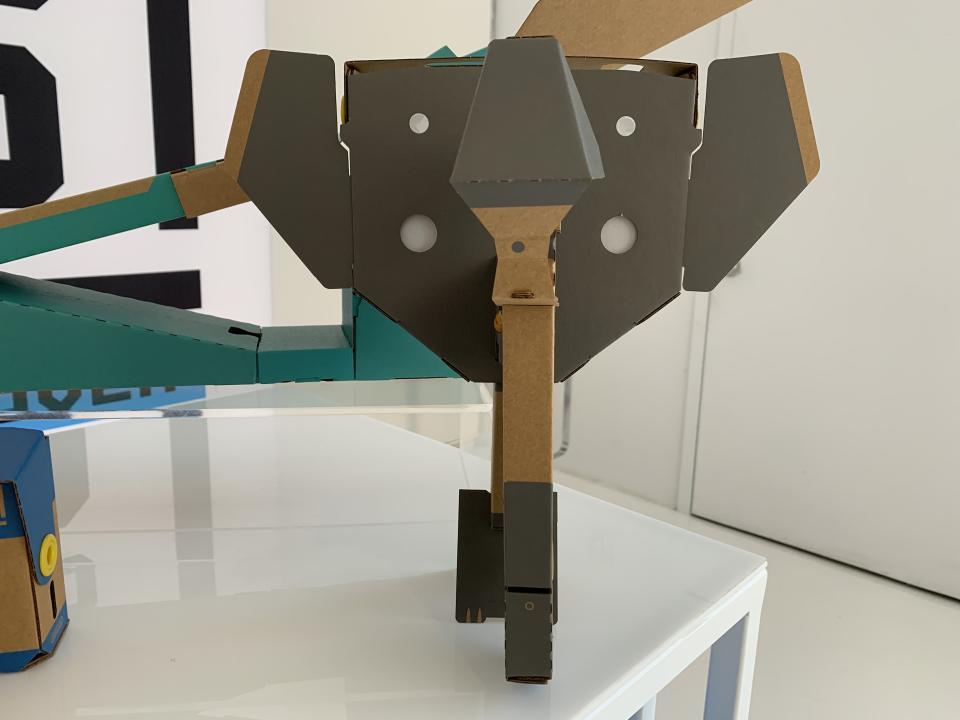
The other Toy-Con, called the Wind Pedal, looks the kick pedal for a drum kit. When you press on it, a burst of air shoots out of a hole on the far end of it. Holding the Viewer in your hands, the pedal lets you play games like “Hop Dodge,” where you press the pedal to make a frog jump and dodge colorful balls being thrown his way by a bear.
As a virtual reality experience, Labo VR is a mixed bag. On the one hand, the games do a great job of evoking a sense of virtual place. With balls whizzing overhead in the “Blaster” shooter gallery, or fish swimming up to you in the “Ocean Camera” game, you not only get a sense of depth but the feeling that you’re present wherever it is you’re playing. That’s more than I’ve come to expect from most mobile VR experiences.
On the other hand, the Switch’s 720p screen cannot deliver a clear picture in VR mode: Most objects feature fuzzy, pixelated details and rough edges. It’s never difficult to make out what you’re looking at, important because it means the low fidelity isn’t straining your eyes, but it does put a damper on the experience. You’ll never get truly lost in a VR world with jagged edges.
If jagged edges are too much for you, or if VR makes you nauseous, it is possible to switch any of Labo VR’s core games from VR to a much sharper 2D experience. These games still work with the Toy-Cons — instead of the viewer, you can attach a holster for the Switch console to hold the hardware in place. Without VR, many of the games seem far less compelling, but it is a neat option, especially for parents of young children who may not want their kids using VR yet.
Plus, these VR games are clearly meant to entertain in short bursts. Nintendo isn’t making VR worlds, but “bite-size” games made to be consumed in very small chunks.
“It’s meant to be shared,” said Robertson. “It’s meant to be passed around.”
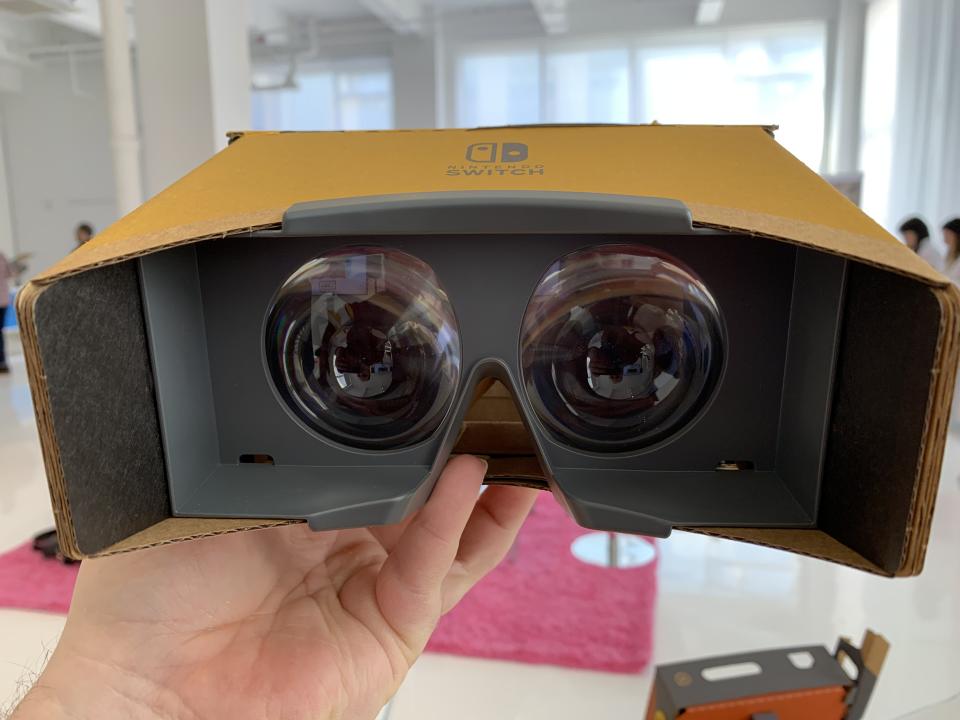
None of the Toy-Cons include any kind of head strap, so you have to hold your Switch up to your face to play. Even in short bursts, some of the kits started to feel heavy in-hand before too long. Likewise, many of the games have frequent cutoff points built into their gameplay. The camera, for example, only lets you take three photos on a standard run before kicking you back to a menu to see if you accomplished any of your photographic goals.
The games were designed with natural stopping points, in part, as a mitigating factor against children straining themselves using VR. While the word is still out as to virtual reality will have any adverse effects on children physically or psychologically, the prevailing wisdom has been to limit children’s access to VR. Sony, for example, advises that children under 12 do not use its PlayStation VR headset. According to Nintendo PR Manager Camille Van Duyn, the developer reviewed academic materials on the effects of virtual reality on children: Based on its findings, Nintendo recommends keeping children under seven years old from playing the games in VR.
“That is one of the reasons we included the 2D mode,” said Van Duyn. “So that everyone, even if they are a younger child, can enjoy the experience and participate with their family or their friends.”
In addition to the Toy-Cons and the flagship games made for each of them, the Labo VR Kit software will include a grab bag of 64 smaller games and experiences called the VR Plaza. The Plaza, which despite the name features both VR and 2D concepts, serves as a bridge between Nintendo’s primary games and Labo’s Toy-Con Garage creation toolkit. Each of the games in the VR Plaza was made using the Toy-Con Garage: As with their creations, players can check the if-this-then-that-style programming for each of VR Plaza game and/or modify them to create new variations. If you’re looking to play, they add more games to try. If you’re looking to build, they can serve as templates to help you find your footing.
Nintendo showed Variety six of the 64 VR Plaza games — three VR concepts and three made for 2D play. Of the six, many were basic reproductions of experiences you already know. Some of the VR experiences include a platformer, where you jump over game-ending red obstacles; a Pinball table; and a “roller whack-a-mole” experience where you drive a car equipped with a mallet and try to destroy other cars. The non-VR games included a classic top-down tilting ball game, and a multiplayer take on foosball where you control two characters who move in strict formation, as you control them with a single set of inputs. Last but not least, there was a simplified recreation of “Super Smash Bros.” where two players, each using a single Joy-Con, use punches to push each other off the edge of a stage.
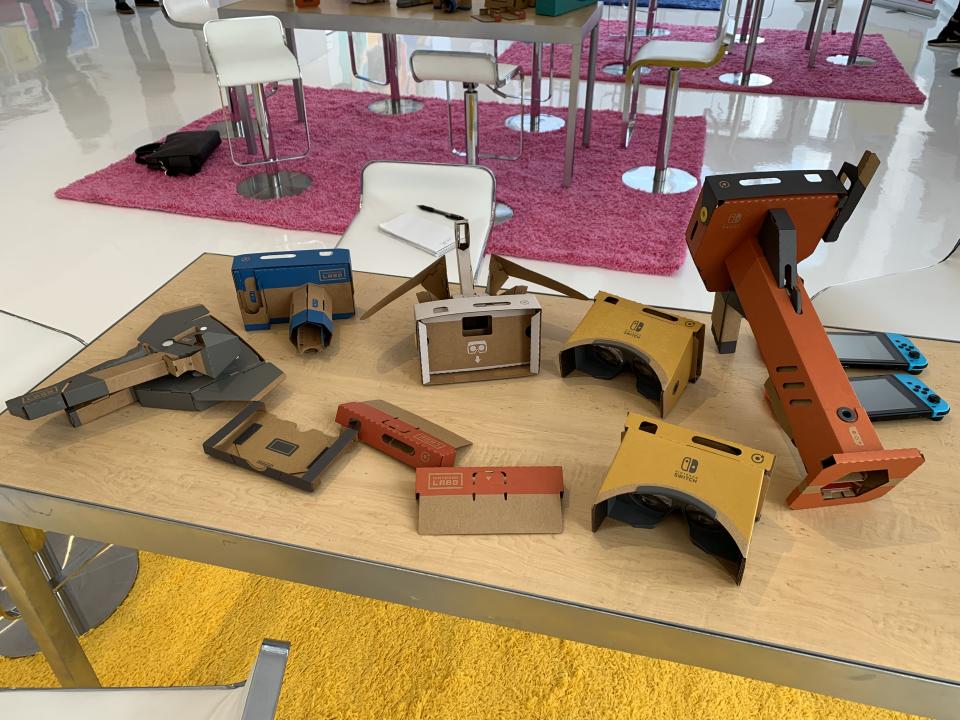
All this leads, of course, to the Labo VR Kit’s expanded version of the Toy-Con Garage. Called Toy-Con VR Garage in this game, the creative side of Labo appears to work identically to past Labo kits, but with an expanded with new input and outputs related to the VR Kit’s Joy-Cons and VR in general. Like the Variety and Vehicle Packs, players can create tools. Given that all of these Toy-Cons are essentially controllers for VR experiences, there is a stronger emphasis on making games in the VR Kit Garage, as opposed to the Starter Kit where Nintendo pushed players to dream up contraptions that used the Toy-Cons to make real-world contraptions. Though VR is at the forefront, you have the tools to create 2D games as well; opening the door for a wide array of game experiences.
Since Garage is largely unchanged, the same limitations apply. Like the other sets, Nintendo Labo VR Kit is siloed off from the others. The VR Garage is compatible with the VR Toy-Cons, but not the previous kits. There’s also no online platform for uploading or downloading your Toy-Con Garage designs. And though you can share your Labo Camera photography and 2D versions of your Elephant Toy-Con designs via the Switch’s screenshot tool, there is no natural solution for players who want to share their work. There are obvious privacy and content concerns for parents around content publishing, but Nintendo Labo VR Kit already has parental controls to restrict whether children can play in VR; Why can’t they be expanded to regulate posting to some kind of kid-friendly Labo Online platform? With more creative pursuits than previous kits, the lack of infrastructure for sharing creations and designs seems like a more pronounced Achilles’ Heel for the VR Kit, and for Labo in general.
We’ll find out if young players and parents feel the same when the Nintendo Labo VR Kit launches April 12.
Sign up for Variety’s Newsletter. For the latest news, follow us on Facebook, Twitter, and Instagram.

